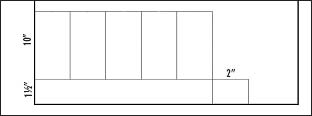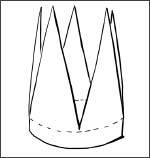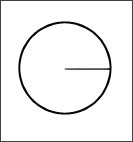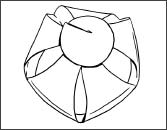The Time Travelers' Handbook (6 page)
Read The Time Travelers' Handbook Online
Authors: Lottie Stride


You find yourself in a wooden hut among a crowd of men. They are huddled together, talking in whispers. You have landed in Germany during World War II, in a camp full of prisoners of war. The men around you are prisoners from the British air force, and they are about to embark on a daring breakout.
You feel a sense of urgency in the air; you hear it in the whispered, panicky conversations; you see it in the eyes of the lookouts by the door who are checking right and left for German soldiers.
Under Their Feet
The Germans think their camp, called Stalag Luft III, is impossible to escape from. They're wrongâ76 prisoners are about to do just that, making their escape through a tunnel right under the Germans' feet.
In front of you is the mouth of a tunnel and it's uncovered. One after another, men are disappearing into it as fast as they can. The escape has taken months of planning and preparation. Now, the moment has come. Before you know it, it's your turn to duck through the trapdoor. You are part of the Great Escape!
The Plan So Far
The escape was masterminded by a man known as “Big X.” He has organized teams of prisoners to build three tunnels, which he has named Tom, Dick, and Harry.
The Germans soon realized the prisoners were digging, and discovered one tunnelâTom. However, they haven't found Dick or Harry.
Harry was the tunnel chosen for the escape. It stretches over 100 yards under the camp. Its entrance is hidden under the stove in one of the huts in which the prisoners sleepâhut 104.
The tunnelers have had to dig deep to avoid sound-detecting machines the Germans have rigged up around the compound. They had to use wooden supports to keep the tunnels from collapsing. The woo d came from the boards of the prisoners' bunk beds. They used 4,000 boards, and by the time they had finished, no one was getting a good night's sleep.

The tunnels needed air pipes so that those crawling through them wouldn't suffocate. So, the tunnelers joined empty milk powder cans together to make pipes.
The tunnelers dug for up to six hours at a time. At first, they worked in their undershirts and long johns, but in the damp tunnel, their clothes got wet and smelly. In the end, they decided it was easier to wear nothing at all.
Hitches
One of the prisoners explains to you that the biggest problem they had was getting rid of all the sand that was dug out as the tunnels were built. The Germans had discovered earlier tunnels had been built by spotting the white sand on the blackish gray earth in the camp compound. This time, there were 250 tons of sand to hide.
Finally, the planners came up with a great method that got rid of almost half the sand. Men known as “penguins” stuck one-and-a-half-foot long, sausage-shaped bags made out of towels down each of their trouser legs. The bags were filled with sand and were held by a sort of sling around the prisoner's neck.
The prisonerâoften wearing a coat to hide the bulky bagsâwould then walk over to another prisoner who was working in the camp garden. He would stand in the dirt and release the sand. Then the gardener would quickly cover the white sand with soil.
Nerves
Now that the night of the escape has come and the plan is under way, the prisoners are tense and nervous. They feel that time is against them. It's the coldest March in 30 years, and the trapdoor at the far end of the tunnel has iced up, slowing things down.

They dig the last two feet to the surface, but find they are about 10 feet away from the edge of the forest. There's a real danger that men will be spotted running across the open ground to the trees. Then, someone has a good idea. They rig up a rope that stretches from behind a bush into the tunnel. One prisoner hides behind the bush. He can see the German sentries on guard. He will give one tug on the rope when it's OK for the next prisoner to run from the tunnel to the forest. Two tugs means to stay put inside.
Some men are panicking in the tunnel because of the long wait. One knocks out a wooden support with his suitcase by mistake and lots of sand falls down. Then, the lights in the tunnel suddenly go out, so it's pitch black.
Despite all these hitches, however, you count 76 men escaping through the tunnel and beginning their long journey to freedom. You wish them luck as they scatter in all directions into the dark night. Then you press EJECT.

You land with a jolt to find yourself balancing precariously on the high wall of Hawarden Castle in Wales. A soldier pulls you down from the wall, but as you start to thank him, you see a pretty scary sight. The castle, which stands on top of a hill, is under siege. The sword-wielding army of a Welsh prince named Dafydd ap Gruffudd ap Llywelyn has surrounded the castle and is attacking relentlessly.
The soldier who grabbed you tells you that he and his fellow soldiers have been fighting the Welsh for many yearsâsince 1067, in fact. They built castles along the border with Wales, but failed to completely conquer the Welsh. The mountainous, rugged terrain of Wales and the fierce fighting of the Welsh denied them victory.
The Call To Arms
It's only recently, in 1277 under the rule of King Edward I, that the conquest of Wales was completed. To cement his victory and maintain control of the land, Edward has built several massive stone castles, including this one. Unfortunately, the Welsh are still angry and keep revolting against the invaders. This is their strongest revolt yet.
The soldier thrusts a crossbow into your hands and tells you to prepare for battle. To your left and right are men armed with bows and arrows, crossbows, or leather pouches filled with stones.

As the attacking army advances up the hill, the soldier quickly shows you how to use the shape of the wall to your advantage.
The wall has been built with a series of square holes cut into the top of it called crenellations. The English soldiers can shoot their arrows through these holes, and then retreat behind the cover of the wall. In the walls of the towers, there are also thin windows known as arrow loops, which are just the right size to shoot arrows through, but very difficult for the attackers down below to aim at.
In between firing arrows, the soldier tells you that this attack has been going on for many days. Roger of Clifford holds this castle and the surrounding settlements for the king. He has retreated with his family and servants into the keepâthat is, the inner part of the castle behind you and the strong castle walls.

The keep is the safest place to be. Inside the keep there is enough food, water, and provisions stored to keep people going for weeks.
Your friend praises the great work you're doing with the crossbow, but points out that the Welsh army is coming up the hill toward the castle's battlements with a nasty-looking battering ram. They plan to break down the heavy wooden gates. You look worried, but he doesn't seem too concerned. He points to the battlements above the gatehouse, where an enormous cauldron of water is being heated over a fire. In the floor beneath are the delightfully named “murder holes,” through which the cauldron will be emptied. As soon as the attackers get too close, they are going to get a very nasty scalding.
Next, however, the Welsh army starts using massive catapults, called trebuchets, to launch boulders at the outer walls. Soon, you see enemy soldiers swarming into the castle through the huge holes that the boulders have made. You decide it's all getting a bit too close for comfort, and as an arrow whizzes past your ear, you decide it's time to hit EJECT and head home.
How To Make A Medieval Helmet
You can make your own medieval helmet. Then, you will have it ready the next time you are under siege.
You will need:
⢠a large piece of silver cardstock ⢠scissors ⢠tape ⢠a pencil ⢠a ruler ⢠some string ⢠a glass jam jar
1.
Measure around your head using the piece of string. To do this, hold your string at one end against your forehead one inch above your eyebrows, and wrap the rest of it around your head until the length of the string touches the end. Hold on to the string at the point where it meets the loose end and measure from that point to the end using your ruler. Make a note of the length of the string.
2.
Take your cardstock and lay it down lengthwise in front of you, silver-side down. Measure from the left edge of your cardstock the length you noted down and mark it clearly.

3.
Measure and mark 11/2 inches up from the edge of the card nearest you. Use this mark to draw a rectangle 1½ inches by the length of your string. Add an extra 2 inches to the right of your rectangle. This will be used to fasten your helmet.
4.
Measure and mark 10 inches up from the 1½ inch line. Divide this up into five equal rectangles (ignoring the 2 inch fastener).

5.
Next, take your ruler and place it along the line you have drawn farthest from the bottom of your card. Measure and mark the midpoint of each of the five rectangles.

6.
Now, use your ruler to draw lines linking the corners of each rectangle along the 11/2 inch line up to the midpoints of the rectangles along the 10 inch line. This will give you five triangle shapes. Cut out your helmet as shown above, putting your leftover card to one side for later.

7.
Next, roll your cutout into a tall crown shape, silver-side out.
8.
Use the 2 inch tab to fasten your helmet by making sure it overlaps fully. Secure this with tape.
9.
Take your jam jar and place it open-side down onto the plain side of your leftover card. Draw around it using a pencil and cut out the circle.

10.
Mark the midpoint of your circle and then cut a single line from the edge of the circle to the midpoint. Bend your circle of card into a cone shape and secure this with tape.
11.
Take some leftover card and draw a rectangle measuring 8 inches by 2 inches and cut it out. This will be your nose piece.
12.
Take your helmet and carefully bend in the triangles until they meet in the middle to make a tall dome shape. Stick these together using tape. Don't worry if this looks messyâyou won't be able to see this when you've finished.

13.
Use more tape to stick your cone shape to the top of your helmet. It should cover up the joined tops of your triangles and make your helmet more secure.
14.
Your helmet is almost finished. Take the nose piece and bend it in half lengthwise so that the two plain edges meet. Unfold it again. This should have made a ridge down the middle. Tape this to the inside of your helmet.
